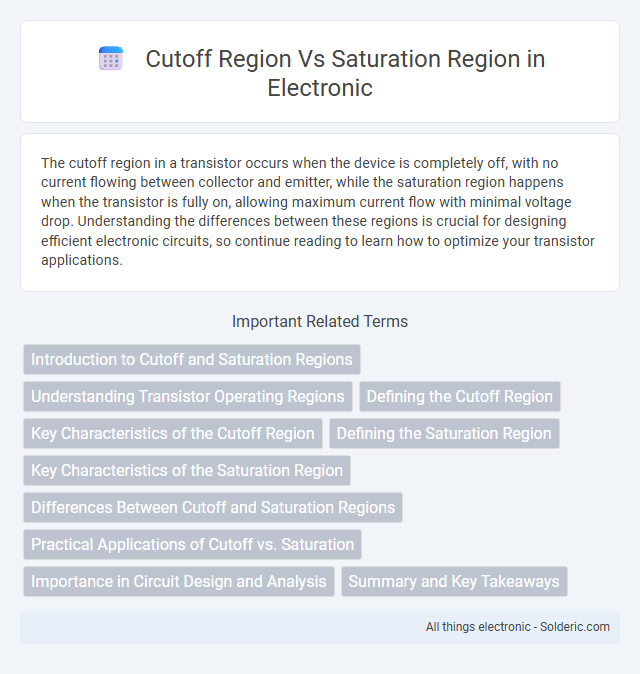The cutoff region in a transistor occurs when the device is completely off, with no current flowing between collector and emitter, while the saturation region happens when the transistor is fully on, allowing maximum current flow with minimal voltage drop. Understanding the differences between these regions is crucial for designing efficient electronic circuits, so continue reading to learn how to optimize your transistor applications.
Comparison Table
| Aspect | Cutoff Region | Saturation Region |
|---|---|---|
| Definition | Transistor is OFF; no conduction between collector and emitter. | Transistor is fully ON; maximum conduction between collector and emitter. |
| Base-Emitter Voltage (V_BE) | Less than threshold (0.7V for silicon BJTs). | Greater than threshold (>=0.7V for silicon BJTs). |
| Collector-Emitter Voltage (V_CE) | Approximately equal to supply voltage (maximum). | Very low voltage (close to saturation voltage, typically 0.1V - 0.3V). |
| Collector Current (I_C) | Approximately zero (no current flows). | Maximum current limited by external circuit. |
| Operation Mode | Switch OFF state (cutoff). | Switch ON state (saturation). |
| Application | Used to turn devices OFF in switching circuits. | Used to turn devices ON in switching circuits. |
Introduction to Cutoff and Saturation Regions
The cutoff region in a transistor is where the device is fully off, meaning no current flows between the collector and emitter, as the base-emitter junction is not forward biased. In contrast, the saturation region occurs when both the base-emitter and base-collector junctions are forward biased, allowing maximum current flow with minimal voltage drop across the transistor. Understanding these regions helps you control transistor operation for switching applications and amplifier design.
Understanding Transistor Operating Regions
The cutoff region occurs when the transistor's base-emitter voltage is below the threshold, resulting in no current flow through the collector-emitter path, effectively turning the transistor off. In contrast, the saturation region is characterized by both the base-emitter and base-collector junctions being forward biased, allowing maximum current flow and turning the transistor fully on. Understanding these operating regions is crucial for designing switching circuits and amplifiers, as they define the transistor's behavior as either a switch or an active device.
Defining the Cutoff Region
The cutoff region in a transistor is defined as the state where both the base-emitter and base-collector junctions are reverse-biased, resulting in no current flow from collector to emitter. In this region, the transistor is essentially turned off, acting as an open switch with minimal leakage current. This contrasts with the saturation region, where both junctions are forward-biased, allowing maximum current conduction.
Key Characteristics of the Cutoff Region
The cutoff region is defined by both base-emitter and base-collector junctions being reverse-biased, resulting in no collector current flow and the transistor acting as an open switch. In this state, the transistor is effectively off, exhibiting maximum resistance between collector and emitter terminals. This region is crucial for digital switching applications where the transistor must represent a logic '0' by completely blocking current.
Defining the Saturation Region
The saturation region of a transistor is defined as the operating state where both the base-emitter and base-collector junctions are forward-biased, allowing maximum current flow from collector to emitter. In this region, the transistor acts like a closed switch, enabling low voltage drop and high current conduction. Understanding the saturation region is crucial for designing efficient switching circuits where transistor rapid switching is required to control power flow.
Key Characteristics of the Saturation Region
The saturation region in a transistor is characterized by both the base-emitter and base-collector junctions being forward biased, allowing maximum current flow through the device. In this region, the transistor operates as a closed switch with minimal voltage drop across the collector-emitter path, typically around 0.2V for silicon BJTs. This state ensures maximum collector current, making it ideal for switching applications where the transistor must act as a low-resistance conductor.
Differences Between Cutoff and Saturation Regions
The cutoff region in a transistor occurs when the base-emitter voltage is below the threshold, resulting in no collector current and the device being fully off, while the saturation region happens when both the base-emitter and base-collector junctions are forward biased, causing maximum collector current and the transistor to be fully on. Cutoff is characterized by zero conduction and high voltage drop across the collector-emitter terminals, whereas saturation exhibits minimal voltage drop and maximum conduction. These differences are critical in switching applications, where cutoff ensures no current flow and saturation guarantees maximum current flow through the transistor.
Practical Applications of Cutoff vs. Saturation
Cutoff and saturation regions in transistors correspond to the switch-off and switch-on states, respectively, making them fundamental in digital logic circuits and switching power supplies. The cutoff region ensures minimal leakage current, enabling effective signal isolation in logic gates, while the saturation region allows maximum current flow for efficient conduction in amplifiers and power regulation. Designing circuits with precise control over these regions enhances performance in applications such as microcontrollers, MOSFET-based switches, and digital signal processing.
Importance in Circuit Design and Analysis
The cutoff region, where a transistor is off with no current flow, is crucial for designing digital switches and ensuring zero leakage current in circuits. The saturation region, characterized by maximum current flow and minimal voltage drop, is essential for achieving efficient amplification and switching with low power loss. Understanding the behavior of transistors in both cutoff and saturation regions enables precise control of signal flow and power management in integrated circuits and analog devices.
Summary and Key Takeaways
The cutoff region in a transistor occurs when the base-emitter voltage is below the threshold, resulting in no collector current and the transistor being off. The saturation region happens when the base-emitter voltage is sufficiently high, causing maximum collector current flow and the transistor being fully on. Understanding these regions is essential for designing switching circuits and ensuring efficient transistor operation.
Cutoff region vs Saturation region Infographic

 solderic.com
solderic.com